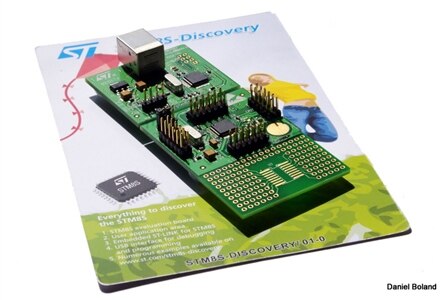Introduction
Currently at £5.25 at Farnell, the STM8S Discovery is the cheapest way to break into microcontroller (MCU) development. With the inclusion of a touch-sensitive electrode, it’s a refreshing change from the array of cheap demo kits I’ve got lying around. The programmable microcontroller is the STM8S105C6, one of ST’s 8-bit MCUs featuring a clock speed of up to 16MHz and 32KB of flash. The list of peripherals can be seen in its datasheet and is pretty standard, with 38 I/O pins, a 10 bit ADC and debugging ability. One neat feature is the programmer can be snapped off and used separately from the rest of the board.
The ST toolchain is unfortunately Windows only, and there’s a choice of two compilers to use - Raisonance or Cosmic. Both compilers offer a free license to compile 32kb applications. Linux support would be nice, but for now, AVR is still the choice for the non-windows user.
The ST toolchain is unfortunately Windows only, and there’s a choice of two compilers to use - Raisonance or Cosmic. Both compilers offer a free license to compile 32kb applications. Linux support would be nice, but for now, AVR is still the choice for the non-windows user.
Setup
The Discovery comes preloaded with a demo program which demonstrates the use of the touch sensor and an included LED. It can be run by simply connecting the board to a computer via a USB A to B cable (not included). If you place a finger on (or even just very close to) the sensor, the LED will flash at different rates. The code for this demo is included on ST’s Discovery website and is written for Cosmic’s C compiler. Raisonance have produced an Application Note for porting code written for the Cosmic compiler. I happened to choose Raisonance and so getting started with compiling the demo took a bit of work, choosing Cosmic should be easier, though I’ve yet to try it.Documentation
Given how cheap the STM8S Discovery is, it would be ideal for beginners and for educational use. I was surprised then at the complete lack of documentation catering to such an audience. The website includes a forum which so far just seems to reflect a great deal of confusion amongst users, it is active however so should become a useful resource. Thankfully there are quite a lot of application notes about developing touch sensitive applications which, while not useful to the MCU beginner, do serve as a nice entry point into touch-sensing.Application
Given the fact that the development tools are Windows only, this severely limits the amount of time available to me to put the STM8S Discovery through its paces. Not to mention the demo code being written only for Cosmic C and the work needed to get it working in Raisonance. After the initial ‘cool’ factor of the touch sensor has passed, this kit’s great weakness shows, which is that there isn’t much more to be done with it as-is.Once the new semester begins I’ll definitely be fabricating some PCBs to fully try out the touch library (the app notes cover sliders, iPod style wheels and backlit sensors). In the mean time I’ll dig out an IR LED and whip up a touch-sensitive remote for my new DSLR, I’ll update as appropriate.
(Premature) Conclusion
For the price, this kit is a no-brainer. I’d really like to recommend it to lecturers for use in the teaching labs but the lack of beginner support is a potential sticking point. The ability to develop touch applications would no doubt help interest students in MCU programming. For those on a tight budget, getting into MCU development for a fiver is a great deal, similarly for those interested in touch sensitive applications. For a little more money however, there are other options with much more support and on-board peripherals. As I do work using this kit and the associated libraries, I will update this review and conclusion.

